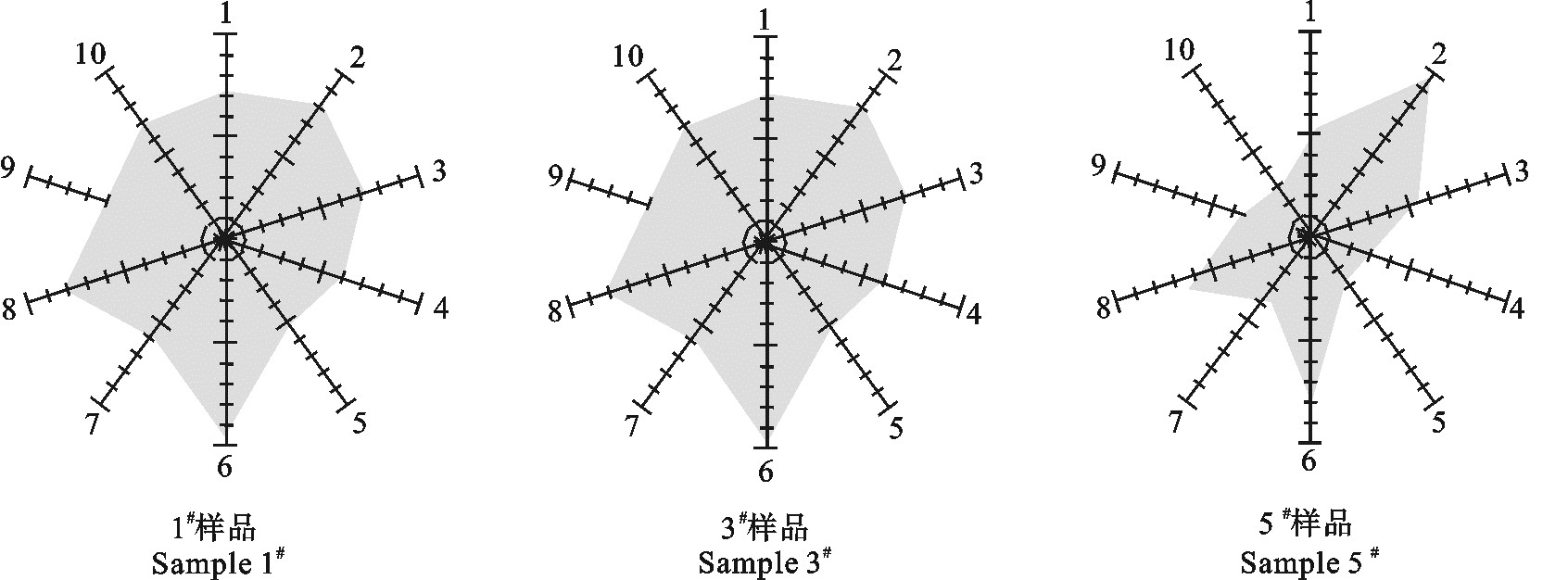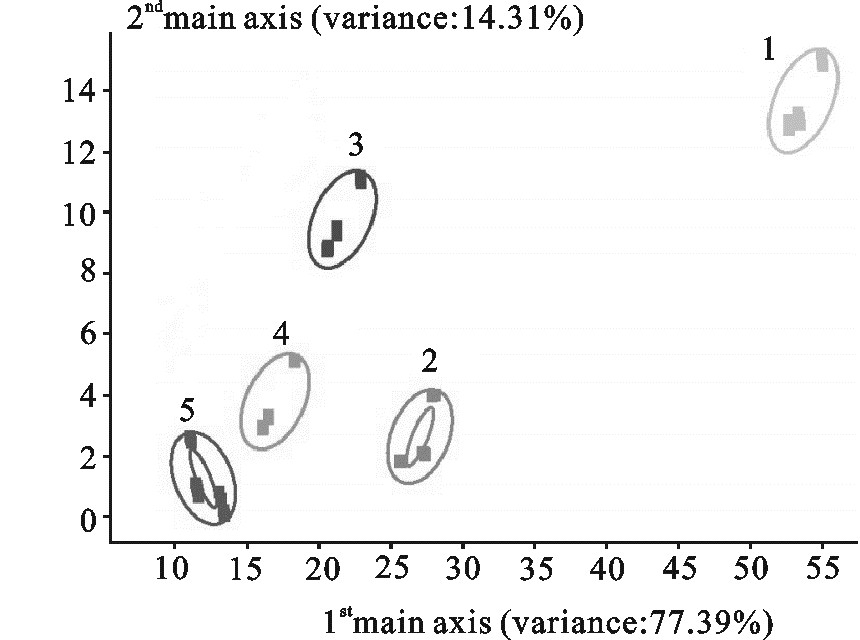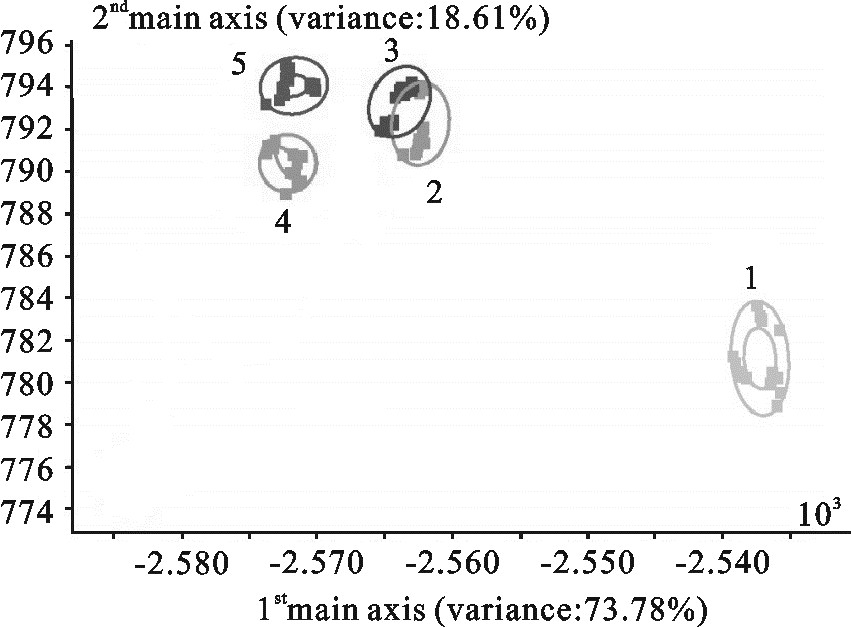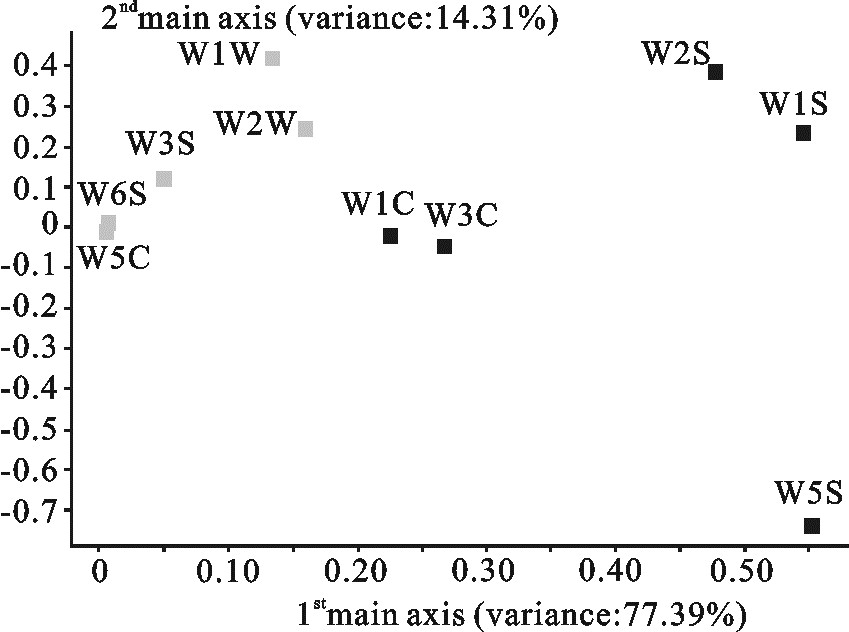Discrimination of tilapia at different frozen storage time by electronic nose
-
摘要:
利用PEN3型电子鼻对不同冷冻贮藏时间的尼罗罗非鱼(Tilapia nilotica)鱼肉进行分析,考察了冷冻贮藏时间对罗非鱼肉挥发性物质的影响, 并对所获得试验数据进行了主成分分析(PCA方法)和线形判别分析(LDA方法)。结果显示,电子鼻传感器可以用于区别不同冷冻时间的罗非鱼肉,PCA方法和LDA方法均能较好地辨别出不同贮藏时间的冷冻罗非鱼肉。PCA方法中第一主成分区与第二主成分区的贡献率之和为91.69%,2个主成分已经基本代表了冷冻罗非鱼肉的主要特征信息;LDA方法则呈现出较好的集中性和单向趋向性,两判别式的总贡献率为92.39%。采用LOADINGS分析方法得出传感器W5S、W1S、W2S和W1W在该试验的检测过程中贡献率大,可以根据具体的试验条件对电子鼻传感器的阵列组合进行优化。
Abstract:We detected tilapia at different frozen storage time by an electronic nose (PEN3) and analyzed the effect of frozen storage time on its flavor. The data was analyzed by PCA and LDA methods. The results show that electronic nose can discriminate tilapia at different frozen storage time especially well by PCA and LDA methods. The first and second main axes generally represent the main characteristic information of frozen tilapia, whose sum of variances is 91.69% by PCA method. The sum of variances of the first and second main axes is 92.39% by LDA method which has good concentration and single tendency.In addition, sensors W5S, W1S, W2S and W1W in electronic nose (PEN3) analyzed by LOADINGS method play a key role in the detection. Therefore, the screen matrix arrangement of sensors of electronic nose can be optimized according to specific experimental conditions.
-
尼罗罗非鱼(Tilapia nilotica)是世界重要的淡水养殖鱼类,原产于非洲,被誉为未来动物性蛋白质的主要来源之一。中国是罗非鱼养殖大国,罗非鱼片已是中国出口农产品中的一个品牌产品[1-2]。因此,冷冻贮藏过程中罗非鱼肉的品质变化已成为罗非鱼行业的一个研究热点,而贮藏过程中罗非鱼肉气味的变化则是品质变化的一个重要指标。国内外已有部分研究人员利用GC-MS等试验方法测定了冷冻贮藏过程中罗非鱼肉挥发性物质的变化,而利用电子鼻做相关方面研究的报道[3-8]还较少。
电子鼻又称气味扫描仪,是20世纪90年代发展起来的一种快速检测食品的新颖仪器。它以特定的传感器和模式识别系统快速提供被测样品的整体信息,指示样品的隐含特征[9]。电子鼻主要由一个具有部分专一性的电子化学传感器阵列和一个合适的模式识别系统组成,能够识别单一的或复合的气味, 还能够用于识别单一成分的气体蒸汽或其他混合物;与气相色谱、质谱等技术相比,电子鼻更加简单快捷[10-11]。文章主要利用电子鼻对不同冷冻贮藏时间的罗非鱼肉进行检测,并对试验结果进行主成分分析、线性判别分析及LOADINGS分析,进而推断电子鼻用于判别不同冷冻贮藏时间罗非鱼肉的可能性。
1. 材料与方法
1.1 材料
鲜活尼罗罗非鱼于10月购自广州华润万家超市,体质量约为0.5 kg。
1.2 仪器
PEN3型电子鼻(德国Airsense公司出品);LG低温冰箱(泰州乐金电子冷机有限公司出品);T25 basic型匀浆机(德国IKA公司出品)。
1.3 方法
1.3.1 样品准备
将鲜活的罗非鱼处死后在流动的冰水条件下取肉,将鱼肉分装于5个密封包装袋中于-18℃条件冷冻贮藏(表 1)。
表 1 样品冷冻贮藏时间Table 1. Storage time of frozen tilapia样品名称
sample No.贮藏时间/月
storage time/month1# 1 2# 2 3# 3 4# 4 5# 8 1.3.2 电子鼻检测参数
分别将1#、2#、3#、4#和5#鱼肉样品粉碎、匀浆,准确称取5 g于20 mL顶空采样瓶中,于25 ℃条件下放置30 min,之后直接将电子鼻进样针头插入顶空采样瓶中进行测定。电子鼻测定条件是传感器自清洗时间为200 s,传感器归零时间为10 s,样品准备时间为3 s,进样流量为300 mL·min-1,分析采样时间为60 s,每个样品重复3次。PEN3型电子鼻有W1C、W5S、W3C、W6S、W5C、W1S、W1W、W2S、W2W和W3S共10个不同的金属氧化物传感器,组成传感器阵列,每个传感器针对不同的物质具有最大响应值,其具体性能见表 2。
表 2 传感器性能描述Table 2. Properties of sensors阵列序号
sensor No.传感器名称
name of sensor性能描述
property1 W1C 芳香成分 2 W5S 灵敏度大,对氮氧化合物很灵敏 3 W3C 氨,对芳香成分灵敏 4 W6S 主要对氢气有选择性 5 W5C 短链烷烃、芳香成分 6 W1S 对甲基类灵敏 7 W1W 对硫化物灵敏 8 W2S 对醇类灵敏 9 W2W 芳香成分,对有机硫化物灵敏 10 W3S 对长链烷烃灵敏 1.4 数据分析
采用DPS数据分析软件对试验数据进行方差分析及Duncan′s多重比较。
2. 结果与分析
2.1 电子鼻传感器响应值变化
除传感器W6S、W1S和W1W外,其余电子鼻传感器对不同贮藏期限的罗非鱼肉的响应值呈显著性差异(P < 0.05)。另外,除W6S和W3S对5种样品的响应值数值基本保持不变外,其他8个传感器对1#、2#、3#、4#和5#样品的响应值均呈上升趋势(表 3)。试验结果表明,多数传感器能有效地通过响应值变化区别5种样品。
表 3 电子鼻传感器对不同样品的响应值变化(X+SD)Table 3. Response values of sensors to different samples传感器
sensor样品sample 1# 2# 3# 4# 5# W1C 1.297±0.059d 1.453±0.002bc 1.441±0.002c 1.522±0.002b 2.047±0.006a W5S 1.473±0.002e 1.633±0.002d 1.507±0.002c 1.821±0.001b 3.665±0.005a W3C 1.302±0.001e 1.446±0.002d 1.423±0.003c 1.513±0.002b 2.119±0.002a W6S 1.075±0.001c 1.032±0.001b 1.078±0.001b 1.084±0.004a 1.088±0.002a W5C 0.983±0.002cd 0.988±0.001c 0.981±0.002d 1.982±0.002a 1.992±0.002b W1S 1.785±0.002c 1.846±0.002c 2.023±0.002b 2.088±0.003b 3.074±0.056a W1W 1.174±0.083b 1.117±0.002b 1.168±0.002b 1.364±0.002a 1.460±0.006a W2S 1.549±0.002e 1.702±0.001d 1.787±0.002c 1.741±0.012b 2.698±0.002a W2W 1.008±0.001e 1.111±0.002d 1.152±0.002c 1.363±0.002b 1.546±0.002a W3S 1.220±0.001c 1.193±0.002d 1.236±0.001b 1.219±0.001c 1.247±0.002a 注:同行数据后的不同小写字母表示存在显著差异(P < 0.05)
Note: Values with different small letters in the same line are significantly different (P < 0.05).2.2 样品特征雷达图
图 1中的1#~10#数轴分别表示10种传感器,可以看出,不同贮藏条件下罗非鱼肉的电子鼻检测雷达图面积明显不同,检测物质变化明显,其中4#、5#、7#和10#数轴的检测结果数值减少较为明显,2#数轴检测结果有所增加,电子鼻可以有效地通过雷达特征图区分样品。
2.3 主成分分析(PCA)
PCA是化学统计学中为分析、分级和减少复杂问题中大量重复数据的一种线性分析方法。PCA方法考察分析数据结构,样品数据变量间的关系,以及变量间的整体相关性。PCA方法的主要特点就是将数据显示在一个新的数标轴上,并将数据重新分配给每一个感应量,形成散点图。数标轴的作用通常为进行数据分级所用,而散点图的作用则是传递阵列传感器中单个分支间的彼此相关性及相关的重要性[12-13]。
鱼肉在冷冻贮藏过程中会发生脂肪氧化等化学反应,从而产生醛酮类物质及一些特殊的挥发性物质。由图 2可知,第一主成分区贡献率为77.39%,第二主成分区贡献率为14.31%,2个主成分区贡献率之和为91.70%,大于90%,所以这2个主成分已经基本代表了样品的主要信息特征,可用来代表冷冻罗非鱼肉的整体信息。且1#、2#、3#、4#和5#样品分别处于不同的区域,冷冻贮藏时间越长,样品越趋向于原点(0,0),一些挥发性物质的变化越明显,说明5种不同处理的样品已完全分开,PCA方法可以很好地区分5种样品,且结果趋势基本呈线性效果。
2.4 线性判别分析(LDA)
LDA方法是一种常用的分级方法,此方法将类别间的方差最大化,将同一类别内的方差最小化。它主要利用类别间离差平方和与类别内离差平方和的比值来实现,比值越大说明类别内与类别间的差异越大,区分效果越好。LDA用相似于PCA的方法以二维或三维空间形式表示出来,运用分类数据的信息对分类集的结果进行优化[14]。与PCA相比,LDA方法主要不同之处在于它利用先前赋予分类信息进行计算,能够注意同一类别内的分布以及它们之间相互距离,因此能够从所有数据中收集信息,提高了分类精度[15]。图 3为不同贮藏条件下5个样品的LDA图。判别式LD1和LD2的贡献率分别为73.78%和18.61%,两判别式的总贡献率为92.39%。可以看出,随着贮藏时间的延长,样品沿第一主成分轴向左分布,与付湘晋等[16]所作主成分分析结果相似,随着贮藏时间的增加,第二主成分所占比重增加,其可能与某些挥发性物质含量变化有关;2#和3#样品并未能较好分开,可能与两者间某些挥发性物质变化不明显有关。结果表明,在常规的试验环境条件下,LDA对不同冷冻时间罗非鱼肉样品具有较好的区分性。
2.5 传感器区分贡献率分析(LOADINGS分析)
采用数据处理软件中LOADINGS分析对传感器贡献率进行分析,该方法可以识别传感器响应在识别模式中的重要性[17]。观察LOADINGS图中不同传感器在坐标轴中的响应,距离原点越远,表示负载参数越大,说明该传感器在分析过程的作用越重要;如果负载参数处于原点(0,0)附近,则表明该传感器的作用可以忽略。图 4为罗非鱼冷冻样品LOADINGS传感器区分贡献率分布图,W2S、W1S和W5S传感器对第一主成分的贡献率比较大,W5S对第二主成分有负载现象;W1W和W2W则对第二主成分的贡献率较明显;W6S和W5C距离原点最近,表明在此次试验分析过程中,两者对结果贡献率最低。
由此可见,同一种样品不同的传感器会有不同的响应,一些传感器贡献率比较大,一些贡献率则不明显,这主要与传感器的特性相关,某一种传感器只对某几种特征物质响应明显;而对不同的样品,同一传感器则也会呈现不同的响应值。所以,在今后试验过程中要根据具体的试验对象,对电子鼻的传感器阵列进行优化,选择最佳的传感器阵列组合,以到达最优的试验效果。
3. 结论
利用PEN3型电子鼻对不同冷冻时间的罗非鱼肉进行检测,不同的检测器对样品的响应值和特征雷达图明显不同。对所得数据结果进行了主成分分析(PCA)、线性判别分析(LDA)和传感器区分贡献率分析(LOADINGS)。
PCA方法中第一主成分区和第二主成分区的贡献率之和为91.69%,表明2个主成分已经基本代表了样品的主要信息特征,LDA方法则呈现出较好的集中性和单向趋向性,PEN3型电子鼻可以较好地区别出不同冷冻时间的罗非鱼肉。在LOADINGS传感器区分贡献率分布分析中,W2S、W1S和W5S传感器对第一主成分的贡献率较大,W1W和W2W对第二主成分的贡献率较明显。由此可见,同一种样品不同的传感器会有不同的响应,应根据具体试验条件进行进行电子鼻传感器阵列的优化[18-20]。利用电子鼻对不同冷冻时间的罗非鱼肉进行检测,数据结果利用LDA和PCA等方法进行分析,可以推断出罗非鱼肉冷冻贮藏时间的长短;与此同时,也可以根据电子鼻的响应值、特征雷达图等检测结果判别出冷冻罗非鱼肉的新鲜程度和品质变化。PCA方法中第一主成分区和第二主成分区的贡献率之和为91.69%,表明2个主成分已经基本代表了样品的主要信息特征,LDA方法则呈现出较好的集中性和单向趋向性,PEN3型电子鼻可以较好地区别出不同冷冻时间的罗非鱼肉。在LOADINGS传感器区分贡献率分布分析中,W2S、W1S和W5S传感器对第一主成分的贡献率较大,W1W和W2W对第二主成分的贡献率较明显。由此可见,同一种样品不同的传感器会有不同的响应,应根据具体试验条件进行进行电子鼻传感器阵列的优化[18-20]。利用电子鼻对不同冷冻时间的罗非鱼肉进行检测,数据结果利用LDA和PCA等方法进行分析,可以推断出罗非鱼肉冷冻贮藏时间的长短;与此同时,也可以根据电子鼻的响应值、特征雷达图等检测结果判别出冷冻罗非鱼肉的新鲜程度和品质变化。
-
表 1 样品冷冻贮藏时间
Table 1 Storage time of frozen tilapia
样品名称
sample No.贮藏时间/月
storage time/month1# 1 2# 2 3# 3 4# 4 5# 8 表 2 传感器性能描述
Table 2 Properties of sensors
阵列序号
sensor No.传感器名称
name of sensor性能描述
property1 W1C 芳香成分 2 W5S 灵敏度大,对氮氧化合物很灵敏 3 W3C 氨,对芳香成分灵敏 4 W6S 主要对氢气有选择性 5 W5C 短链烷烃、芳香成分 6 W1S 对甲基类灵敏 7 W1W 对硫化物灵敏 8 W2S 对醇类灵敏 9 W2W 芳香成分,对有机硫化物灵敏 10 W3S 对长链烷烃灵敏 表 3 电子鼻传感器对不同样品的响应值变化(X+SD)
Table 3 Response values of sensors to different samples
传感器
sensor样品sample 1# 2# 3# 4# 5# W1C 1.297±0.059d 1.453±0.002bc 1.441±0.002c 1.522±0.002b 2.047±0.006a W5S 1.473±0.002e 1.633±0.002d 1.507±0.002c 1.821±0.001b 3.665±0.005a W3C 1.302±0.001e 1.446±0.002d 1.423±0.003c 1.513±0.002b 2.119±0.002a W6S 1.075±0.001c 1.032±0.001b 1.078±0.001b 1.084±0.004a 1.088±0.002a W5C 0.983±0.002cd 0.988±0.001c 0.981±0.002d 1.982±0.002a 1.992±0.002b W1S 1.785±0.002c 1.846±0.002c 2.023±0.002b 2.088±0.003b 3.074±0.056a W1W 1.174±0.083b 1.117±0.002b 1.168±0.002b 1.364±0.002a 1.460±0.006a W2S 1.549±0.002e 1.702±0.001d 1.787±0.002c 1.741±0.012b 2.698±0.002a W2W 1.008±0.001e 1.111±0.002d 1.152±0.002c 1.363±0.002b 1.546±0.002a W3S 1.220±0.001c 1.193±0.002d 1.236±0.001b 1.219±0.001c 1.247±0.002a 注:同行数据后的不同小写字母表示存在显著差异(P < 0.05)
Note: Values with different small letters in the same line are significantly different (P < 0.05). -
[1] 陈胜军, 李来好, 杨贤庆, 等. 我国罗非鱼产业现状分析及提高罗非鱼出口竞争力的措施[J]. 南方水产, 2007, 3 (1): 75-80. doi: 10.3969/j.issn.2095-0780.2007.01.013 CHEN Shengjun, LI Laihao, YANG Xianqing, et al. Present situation of tilapia industry and measures of improving export competition power[J]. South China Fish Sci, 2007, 3 (1): 75-80. (in Chinese) doi: 10.3969/j.issn.2095-0780.2007.01.013
[2] 陈胜军, 李来好, 杨贤庆, 等. 罗非鱼综合加工利用与质量安全控制技术研究进展[J]. 南方水产科学, 2011, 7(4): 85-90. doi: 10.3969/j.issn.2095-0780.2011.04.013 CHEN Shengjun, LI Laihao, YANG Xianqing, et al. Research progress on comprehensive processing & utilization and quality & safety control for tilapia[J]. South China Fish Sci, 2011, 7 (4): 85-90. (in Chinese) doi: 10.3969/j.issn.2095-0780.2011.04.013
[3] CHUNG H Y, YUNG I K S, MA W C J, et al. Analysis of volatile components in frozen and dried scallops (Patinopecten yessoen-sis L. ) by gas chromatography/mass spectrometry[J]. Food Res Int, 2002, 35 (1): 43-53. doi: 10.1016/S0963-9969(01)00107-7
[4] ZHANG Z M, LI G K, LUO L, et al. Study on seafood volatile profile characteristics during storage and its potential use for freshness evaluation by headspace solid phase microextraction coupled with gas chromatography-mass spectrometry[J]. Analytica Chimica Acta, 2010, 659 (2): 151-158. doi: 10.1016/j.aca.2009.11.024
[5] IGLESIAS J, MEDINA I, BIANCHI F, et al. Study of the volatile compounds useful for the characterization of fresh and frozen-thawed cultured gilthead sea bream fish by solid-phase microextraction gas chromatography-mass spectrometry[J]. Food Chem, 2009, 115 (1): 1473-1478. doi: 10.1016/j.foodchem.2009.01.076
[6] 张军. 基于复阻抗特性和电子鼻的淡水鱼新鲜度快速检测方法的研究[D]. 武汉: 华中农业大学, 2008. https://kns.cnki.net/kcms2/article/abstract?v=MdENDFpkZq57Xrpe0ia48bcmoQL-sVEo8Rcx_U5YiVVcXToVFu5ztBsavqzStctM6JjYYB1JqgPlMsU3v5MEE72STgslDg-Kvp_hoK__O9L-4kj3XVHF9wYMV9WOptrmmymTrd6fYqfWwVt7hC5MA6pw6jmb42PIDx1JM20OcN75dcA_azuC9ANHVl6ouwQq&uniplatform=NZKPT&language=CHS ZHANG Jun. Fast evaluation freshness of freshwater fish based on bioimpedance characteristics and electronic nose[D]. Wuhan: Huazhong Agriculture University, 2008. (in Chinese) https://kns.cnki.net/kcms2/article/abstract?v=MdENDFpkZq57Xrpe0ia48bcmoQL-sVEo8Rcx_U5YiVVcXToVFu5ztBsavqzStctM6JjYYB1JqgPlMsU3v5MEE72STgslDg-Kvp_hoK__O9L-4kj3XVHF9wYMV9WOptrmmymTrd6fYqfWwVt7hC5MA6pw6jmb42PIDx1JM20OcN75dcA_azuC9ANHVl6ouwQq&uniplatform=NZKPT&language=CHS
[7] 王国超, 李来好, 郝淑贤, 等. 罗非鱼肉中土臭素和2-甲基异莰醇的检测[J]. 食品科学, 2011, 32 (22): 188-191. https://kns.cnki.net/kcms2/article/abstract?v=MdENDFpkZq6yWbAKH0S8azL256vosdIB0hkkpNWe5G8wL_dt32-7XStCflqQ4PAcB7-l4XIU5XQEQqPlLktECh4T27CPTBdZccxzSC5nkahz3Jcof2GtDXoDcwnxRko9ePKJ59ntKTpv2-ivupDxqEynbNZ4HPVcDz5dV7GaXekJDvyewFPYxV2kdUophoWU&uniplatform=NZKPT&language=CHS WANG Guochao, LI Laihao, HAO Shuxian, et al. Determination of Geosmin and 2-Methylisoborneol in Tilapia meat[J]. Food Sci, 2011, 32 (22): 188-191. (in Chinese) https://kns.cnki.net/kcms2/article/abstract?v=MdENDFpkZq6yWbAKH0S8azL256vosdIB0hkkpNWe5G8wL_dt32-7XStCflqQ4PAcB7-l4XIU5XQEQqPlLktECh4T27CPTBdZccxzSC5nkahz3Jcof2GtDXoDcwnxRko9ePKJ59ntKTpv2-ivupDxqEynbNZ4HPVcDz5dV7GaXekJDvyewFPYxV2kdUophoWU&uniplatform=NZKPT&language=CHS
[8] 柴春祥, 凌云. 电子鼻检测虾新鲜度的研究[J]. 食品科技, 2010, 35 (2): 246-249. doi: 10.13684/j.cnki.spkj.2010.02.070 CHAI Chunxiang, LING Yun. Identification of shrimp freshness by electronic nose[J]. Food Sci Technol, 2010, 35 (2): 246-249. (in Chinese) doi: 10.13684/j.cnki.spkj.2010.02.070
[9] 石志标, 左春怪, 张学军. 新颖的仿生检测技术——电子鼻[J]. 测试技术学报, 2004, 18 (1): 50-55. https://kns.cnki.net/kcms2/article/abstract?v=MdENDFpkZq5DcLsIvRVxOsUFqttGz-dE9v5dP-O2-NTCuUz58sEy3Keo8_tSnX-esSbqCM6NfplWLDM3VOHvqBG8hnoeFwZEvQK_zcsPr99romE-t4apGj7s2CR1E2VgT2zrkIfDfBmFdHbf8xkpt3B4SEFid2LkcQo7CNsb28869IKSyUnFufv77o2ZZe49&uniplatform=NZKPT&language=CHS SHI Zhibiao, ZUO Chunguai, ZHANG Xuejun. A novel bionic examination technique: the electronic nose[J]. J Test Meas Technol, 2004, 18 (1): 50-55. (in Chinese) https://kns.cnki.net/kcms2/article/abstract?v=MdENDFpkZq5DcLsIvRVxOsUFqttGz-dE9v5dP-O2-NTCuUz58sEy3Keo8_tSnX-esSbqCM6NfplWLDM3VOHvqBG8hnoeFwZEvQK_zcsPr99romE-t4apGj7s2CR1E2VgT2zrkIfDfBmFdHbf8xkpt3B4SEFid2LkcQo7CNsb28869IKSyUnFufv77o2ZZe49&uniplatform=NZKPT&language=CHS
[10] PERIS M, ESCUDER-GILABERT L. A 21st century technique for food control: electronic-noses[J]. Analytica Chimica Acta, 2009, 638 (1): 1-15. doi: 10.1016/j.aca.2009.02.009
[11] 刘海燕. 电子鼻系统设计及其应用[D]. 吉林: 东北电力大学, 2011. https://kns.cnki.net/kcms2/article/abstract?v=MdENDFpkZq47VOswmsidDSSgzhhZP5qrM7lee7wb78QR6HXmY61j5u6jEZXADwFiOWaGxLSqDJ-3sEXJk2u7aw3DNv4aNeelQSSbgrQNqWyQdUNgn-JfejvmXnfba5JfC54Mv9UDi4ud6U4p_svHDSYPrDP5XjuE7RlxqygT87NvLbL-UnnXnh0SbZ_Y3xqM&uniplatform=NZKPT&language=CHS LIU Haiyan. Design and application of electronic nose system[D]. Jilin: Northeast Dianli University, 2011. (in Chinese) https://kns.cnki.net/kcms2/article/abstract?v=MdENDFpkZq47VOswmsidDSSgzhhZP5qrM7lee7wb78QR6HXmY61j5u6jEZXADwFiOWaGxLSqDJ-3sEXJk2u7aw3DNv4aNeelQSSbgrQNqWyQdUNgn-JfejvmXnfba5JfC54Mv9UDi4ud6U4p_svHDSYPrDP5XjuE7RlxqygT87NvLbL-UnnXnh0SbZ_Y3xqM&uniplatform=NZKPT&language=CHS
[12] ZHANG Hongmei, WANG Jun. Detection of age and insect damage incurred by wheat with an electronic nose[J]. J Stored Prod Res, 2007, 43 (1): 489-495. doi: 10.1016/j.jspr.2007.01.004
[13] GÓMEZ A H, WANG Jun, HU Guixian, et al. Monitoring storage shelf life of tomato using electronic nose technique[J]. J Food Eng, 2008, 85 (1): 625-631. doi: 10.1016/j.jfoodeng.2007.06.039
[14] 宋伟, 刘璐, 支永海, 等. 电子鼻判别不同贮藏条件下糙米品质的研究[J]. 食品科学, 2010, 31 (24): 360-365. https://kns.cnki.net/kcms2/article/abstract?v=MdENDFpkZq4iUgF267OqY4NbmHrTwLvLcq0gtnxOLJE8H8Lrl2JbqB2zfspKglJ4qpQuCrOa7ss10JBN2hwyshdiPhX_cFk6xxYaL4ovEGA7nA7vEmRLA2fR8cfQIHbrUwhUGvM4lhHwdwYt22unEtUMLNAuWUXY1rB6vdkgQZQ6hCQioaewP1B-jd0kncIL&uniplatform=NZKPT&language=CHS SONG Wei, LIU Lu, ZHI Yonghai, et al. Discriminating the quality of brown rice stored at different conditions by electronic nose[J]. Food Sci, 2010, 31 (24): 360-365. (in Chinese) https://kns.cnki.net/kcms2/article/abstract?v=MdENDFpkZq4iUgF267OqY4NbmHrTwLvLcq0gtnxOLJE8H8Lrl2JbqB2zfspKglJ4qpQuCrOa7ss10JBN2hwyshdiPhX_cFk6xxYaL4ovEGA7nA7vEmRLA2fR8cfQIHbrUwhUGvM4lhHwdwYt22unEtUMLNAuWUXY1rB6vdkgQZQ6hCQioaewP1B-jd0kncIL&uniplatform=NZKPT&language=CHS
[15] 袁志发, 周静芋. 多元统计分析[M]. 北京: 科学出版社, 2002: 216-220. YUAN Zhifa, ZHOU Jingyu. Multivariate statistical analysis[M]. Beijing: Science Press, 2002: 216-220. (in Chinese)
[16] 付湘晋, 许时婴, 王璋, 等. 电子鼻检测白鲢鱼腥味[J]. 浙江大学学报: 农业与生命科学版, 2010, 36 (3): 316-321. https://kns.cnki.net/kcms2/article/abstract?v=MdENDFpkZq4aFBKh3898hVRxpwnNO3ELkvb4bMW7g-ID2AzLeEFILMbz-gGZi6P3zPRNrjjemHl16uVbS60inkgMcl9BwGD-DEDzyLb3LyVkW8zt43_d5lXPSDPQ_DWsFPEM-iYTBLhWf18xx-PsZuv92LCQBIBvaU-Keja6e5w6fjiv2jqBmSfTsBhpbM5X&uniplatform=NZKPT&language=CHS FU Xiangjin, XU Shiying, WANG Zhang, et al. Determination of off-flavors in silver carp mince using electronic nose[J]. J Zhejiang Univ: Agric & Life Sci, 2010, 36 (3): 316-321. (in Chinese) https://kns.cnki.net/kcms2/article/abstract?v=MdENDFpkZq4aFBKh3898hVRxpwnNO3ELkvb4bMW7g-ID2AzLeEFILMbz-gGZi6P3zPRNrjjemHl16uVbS60inkgMcl9BwGD-DEDzyLb3LyVkW8zt43_d5lXPSDPQ_DWsFPEM-iYTBLhWf18xx-PsZuv92LCQBIBvaU-Keja6e5w6fjiv2jqBmSfTsBhpbM5X&uniplatform=NZKPT&language=CHS
[17] 胡桂仙, 王俊, 海铮, 等. 不同储藏时间柑橘电子鼻检测研究[J]. 浙江农业学报, 2006, 18 (6): 458-461. https://kns.cnki.net/kcms2/article/abstract?v=MdENDFpkZq6VvUuzFrRd5FUE9vwJZ7kcdW6Uux286TMFrTYm_Ks4Alrh4WIjTCFU5zTOkDuebHDKo7SNQx7JJeORnmEecG6qedmEZmFt_MGCkdMhtli4sxOEIFTkSzJf_etmoD4lIgJx080GZjMyRHQc_i6pvGXgoP1Ee5wo2FxW8QHqcJlN9gUmH53yIASm&uniplatform=NZKPT&language=CHS HU Guixian, WANG Jun, HAI Zheng, et al. Electronic nose monitoring the oranges stored for different times[J]. Acta Agriculturae Zhejiangensis, 2006, 18 (6): 458-461. (in Chinese) https://kns.cnki.net/kcms2/article/abstract?v=MdENDFpkZq6VvUuzFrRd5FUE9vwJZ7kcdW6Uux286TMFrTYm_Ks4Alrh4WIjTCFU5zTOkDuebHDKo7SNQx7JJeORnmEecG6qedmEZmFt_MGCkdMhtli4sxOEIFTkSzJf_etmoD4lIgJx080GZjMyRHQc_i6pvGXgoP1Ee5wo2FxW8QHqcJlN9gUmH53yIASm&uniplatform=NZKPT&language=CHS
[18] GRIGIONI G M, MARGARÍA C A, PENSEL N A, et al. Warmed-over flavor analysis in low temperature long time processed meat by an electronic nose[J]. Meat Sci, 2000, 56 (3): 221-228. doi: 10.1016/S0309-1740(00)00045-0
[19] RAJAMÄKI T, ALAKOMI H L, RITVANEN T, et al. Application of an electronic nose for quality assessment of modified atmosphere packaged shrimp meat[J]. Food Control, 2006, 17(2): 5-13. https://www.zhangqiaokeyan.com/journal-foreign-detail/070406051866.html
[20] CORRADO D N, MANUELA Z S, ANTONELLA M, et al. Outer product analysis of electronic nose and visible spectra: application to the measurement of peach fruit characteristics[J]. Analytica Chimica Acta, 2002, 459 (1): 107-117. doi: 10.1016/S0003-2670(02)00107-1
-
期刊类型引用(19)
1. 邹丰,王楼. 智能感官技术在水产品检测中的应用进展. 江西水产科技. 2024(01): 20-26 .  百度学术
百度学术
2. 刘美娇,黎铸毅,陈秋翰,杨学博,徐颖怡,刘寿春,钟赛意,洪鹏志,朱春华. 酶解-美拉德反应制备金鲳鱼调味基料的工艺研究及风味分析. 中国调味品. 2024(06): 83-90+118 .  百度学术
百度学术
3. 赵莹鑫,张德权,葛岳,向灿,王振宇,杨伟,侯成立. 包装方式和宰后不同时间包装对羊肉品质的影响. 食品科学. 2022(15): 199-208 .  百度学术
百度学术
4. 熊雅雯,黄卉,李来好,杨贤庆,陈胜军,郝淑贤,吴燕燕,魏涯. 响应面法优化冷冻水煮罗非鱼片稳定剂配方. 食品与发酵工业. 2022(23): 225-234 .  百度学术
百度学术
5. 杭瑜瑜,张伟,张铁涛,于淑池,裴志胜. 真空包装基围虾在不同贮藏温度下的新鲜度分析. 农产品加工. 2021(11): 70-73 .  百度学术
百度学术
6. 李可欣,丁慧璞,周旭静,张捷,张晗琼,刘利萍. 金枪鱼蒸煮汁的抗氧化性、脱腥处理及其风味沙拉酱的研制. 食品工业科技. 2020(04): 153-160 .  百度学术
百度学术
7. 董浩,周晓东,鞠晓晨,钟明慧,赵元晖. 三文鱼在冰箱-18℃、-60℃条件下的冻藏品质变化研究. 家电科技. 2020(S1): 170-174 .  百度学术
百度学术
8. 陈胜军,刘先进,杨贤庆,李来好,黄卉,吴燕燕,李春生. 不同产地鲍鱼特征元素分析与主成分评价模型的建立. 渔业科学进展. 2019(02): 83-90 .  百度学术
百度学术
9. 张四喆,贾文珅,马洁,梁刚,王纪华. 一种高效的冷鲜肉新鲜度检测工具—电子鼻. 分析试验室. 2019(07): 878-884 .  百度学术
百度学术
10. 励建荣,李婷婷,丁婷. 水产品新鲜度综合评价与货架期预测模型的构建研究进展. 食品科学技术学报. 2016(01): 1-8 .  百度学术
百度学术
11. 赵永强,李娜,李来好,杨贤庆,郝淑贤,魏涯,岑剑伟. 鱼类鲜度评价指标及测定方法的研究进展. 大连海洋大学学报. 2016(04): 456-462 .  百度学术
百度学术
12. 李娜,赵永强,李来好,杨贤庆,郝淑贤,魏涯,岑剑伟,张红杰. 冰藏过程中罗非鱼鱼片肌肉蛋白质变化. 南方水产科学. 2016(02): 88-94 .  本站查看
本站查看
13. 明庭红,苏秀榕,周君,李晔,张春丹,季露,孙婷婷,黄忠白,何珊,裘迪红. 基于2种培养基生长的植物乳杆菌发酵草鱼的关键风味比较. 食品科学. 2016(16): 179-186 .  百度学术
百度学术
14. 曾妮,江勇,陈丽丽,白春清,袁美兰,魏颖,赵利. 冻藏前后草鱼肉性质的比较与研究. 食品科技. 2016(03): 156-160 .  百度学术
百度学术
15. 杜利农,柴春祥,郭美娟. 电子鼻在水产品品质检测中的应用研究进展. 电子测量技术. 2014(05): 80-84 .  百度学术
百度学术
16. 周婉君,李来好,吴燕燕,郝淑贤,岑剑伟,魏涯,林婉玲,杨少玲. 罗非鱼休闲食品的工艺技术研究. 食品工业科技. 2014(18): 256-259+263 .  百度学术
百度学术
17. 丁婷,李婷婷,励建荣. 0℃冷藏三文鱼片新鲜度综合评价. 中国食品学报. 2014(11): 252-259 .  百度学术
百度学术
18. 黄洁,李燕,尹芳缘,赵梦田,姜燕,沈凤,王绿野,惠国华,陈裕泉. 使用电子鼻预测低温贮藏罗非鱼储存时间. 传感技术学报. 2013(10): 1317-1322 .  百度学术
百度学术
19. 赵彩芳,许利群,朱燕琳,陈友吾,朱汤军. 不同品种与贮藏期间玫瑰花香味的电子鼻分析. 浙江林业科技. 2013(04): 49-53 .  百度学术
百度学术
其他类型引用(16)



 下载:
下载:




 粤公网安备 44010502001741号
粤公网安备 44010502001741号
